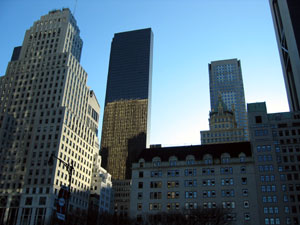Page 1 Page 2 Page 3 Page 4 Page 5

(Part one of a series)
[Synopsis: After several months of scrambling around the New York fashion market in search of an opportunity, as recounted in his previous story “How I Broke Into New York Fashion,” Dean Borok finds employment at Calderon Bags and Belts as an assistant designer, over the heated objections of the company sales manager, Ernie Dornbusch.]
It’s impossible to determine what music soothes the savage beast that resides in the heart of New York City, but in 1982 Madonna was perfecting her formula, singing for dollars at the Danceteria Club on West 21st Street. Michael Bloomberg was taking his lunch at McDonald’s, Bernard Madoff was watching Mr. Rogers and learning to spell P-O-N-Z-I, and young Rudolph Giuliani was having autoerotic fantasies imagining his first party dress.
The green shoots of what would eventually become 21st century New York were springing from the manure pile that was 1980’s New York like the rose that grew out of the sidewalk crack in the old song “Spanish Harlem.”
Then, as now, the economy was like a Toyota that had run out of gas but was still cruising downhill on empty as Ronald Reagan crooned over the radio, like the Britney Spears of his day, singing the refrain from “Morning In America.”
Gangs of overfed rats overran the distressed terrain of the city parks like vast herds of wildebeest traversing the African veldt and luxuriated in filthy ponds of accumulated waste water that collected under the trash-strewn subway tracks, the tiles lining the subway walls yellow and brown from 80 years’ use as an open-air latrine.
The streets were full of crackheads and crazy people who had been turned out of mental hospitals because of budget cuts, and at night even the best neighborhoods went into lock-down mode, but there were plenty of places you dared not go even in broad daylight.
Back in those days a fashion career was a surer route to making a living than being a musician and less stultifying than working in finance or legal services. I once picked up the guitar and learned a few chords, even going so far as learning “The House of the Rising Sun,” but then stopped because I knew that it would distract me from mastering my trade as a designer. I was right, but I was wrong, too, because I have always been sure that I would have had a great band. I was right, because during those years employment was always guaranteed for skilled hands and an agile mind, which explained how I was able to keep finding job after job, despite landing in New York in the midst of a full-blown depression.
To my way of thinking, where did it say a man had to be gay or metrosexual to succeed in fashion, as the stereotype would have it? The way I saw it, a straight guy with an artistic sensibility, who admired women — adored them — might be preferable to an androgynous drip who wanted to emulate them. That concept always drove my motivation. I took my cue from my friend Guy Décarie, a French guy who was an ace with a sewing machine and always accompanied stunning, beautiful girls. My original motivation for starting out in fashion in the first place was to get a lot of women and make some money. I reasoned that the fastest way to get a woman to disrobe was to propose her something even nicer to put on. But being straight in the fashion business worked against me to some extent, and my problem with fashion is the same as that which I hold against society at large, in that the whole thing is run by a soft, white underbelly of metrosexual males.

